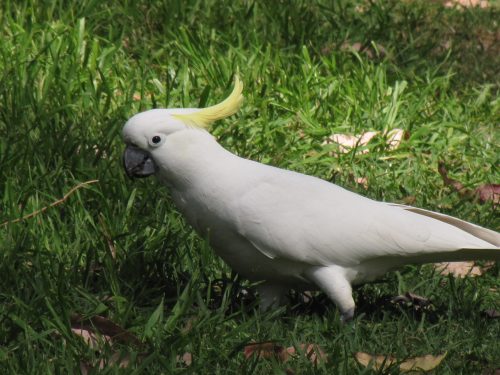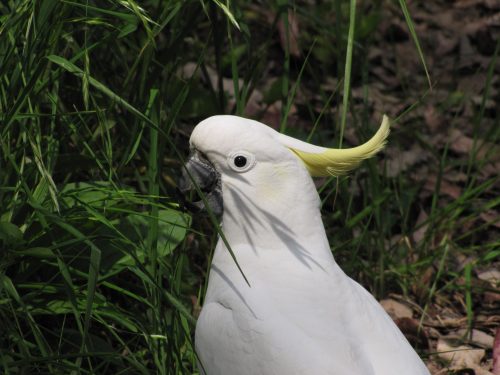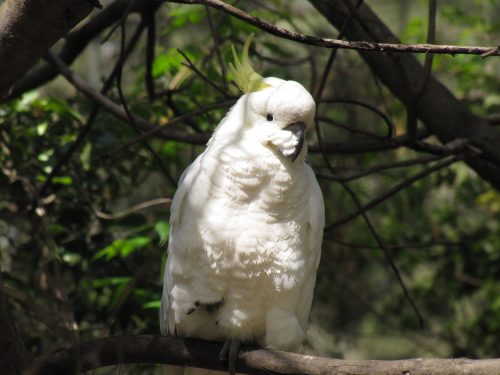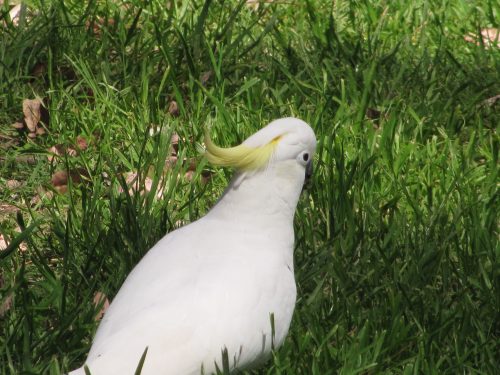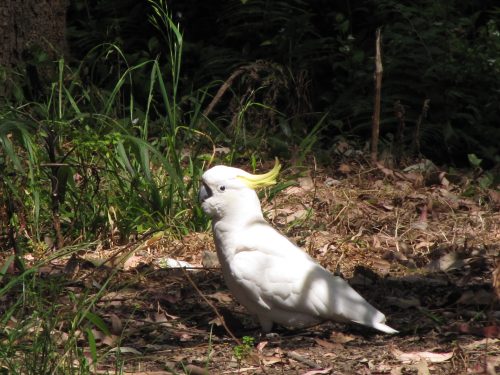Sulphur-crested Cockatoos in Lane Cove
One of Australia’s most recognised and common birds would have to be the Sulphur-crested Cockatoo. I have included a series of photos of this species in this post today. It is found along the north, east and southern coasts of Australia, and in Tasmania. It has been introduced to the south of Western Australia, and in New Zealand.
Large flocks
Throughout its range, it can often be found in large flocks numbering from a few dozen through to many hundreds. In my travels around different parts of Australia, I have observed this species in large numbers, especially where there is an abundance of seed for them to feed on, such as pastures. I have seen large flocks settle in paddocks, making the ground look like snow has fallen. When a flock is feeding on the ground, one or more birds will perch in a tree or on a fence post watching out for any danger. A large flock can also add colour to a dull grey looking gum tree when they all perch together.
Noisy birds
These birds have a very raucous call, and when a flock flies low overhead while calling, it is very hard to carry on a conversation. In some caravan parks we have stayed in where this bird is resident, a noisy flock can be an unwelcome alarm clock, particularly at first light when one wants to sleep in a little. In populated areas, this beautiful bird is often regarded as an unwelcome pest. With such an abundance of food, cockatoos can easily get bored and start chewing on timber work around houses and other buildings. Some of my readers have complained in the past about the destructive nature of this species. There is no easy solution to this problem because this species is a protected bird, like all of our native birds. If you are having a problem with cockatoos, please be in contact with your local National Parks and Wildlife office. It is an offence to destroy them.
Good pets
This species is also a common, long-lived pet for many people. They can be delightful pets and will often learn a range of words and phrases to mimic their owners. I am not familiar with the current regulations on keeping our native birds as pets, so it is best to talk to your local pet shop owners before buying a cockatoo as a pet. They are probably commonly available in pet shops in countries other than Australia. There should be no restrictions on keeping them outside of Australia.
The photos in today’s post were all taken of an individual in the Lane Cove National Park in Sydney. we were staying with our son spending time with our grandchildren during school holidays. On this occasion, we had a few hours break from the children, so we packed a picnic lunch and drove the short distance to the national park. Along the Lane Cove River, there are many lovely grassed picnic areas, complete with picnic tables and gas barbeques for the public to use.
Corellas v Cockatoos
Some people can easily be confused when trying to identify cockatoos and corellas. The three species of corellas in Australia are the Little Corella, Long-billed Corella and the Western Corella. Their ranges often overlap. I have even seen mixed flocks consisting of two species. Corellas are generally a little smaller and all corellas lack the yellow crest of the Sulphur-crested Cockatoos. The calls are also different, with the corellas’ calls being not as loud or as harsh.
Further reading:
- Sulphur-crested Cockatoos up close
- Red-tailed Black-cockatoos
- Gang-gang Cockatoos
- Great Birding Moments #13
- Trevor’s Photos – buy some of my photos on a variety of products such as mugs, place mats, t-shirts and many more.
- Little Corellas at Mannum
- Long-billed Corellas
Corellas calling
We have many different kinds of parrots visiting our garden and five acre block over the course of the year. Some are resident, like the Mallee Ringnecks, others are only occasional visitors. The Little Corella is one of those infrequent visitors and when they do visit, it’s usually just a “flying visit” – meaning – they just fly over without landing. This is despite the species being present in large flocks of 200 – 500 (or more) along the River Murray only 4 – 5 kilometres away (as the parrot flies).
This morning I was busy attending to something when my attention was drawn to an unusual call outside – unusual for our bird life, that is. I instantly recognised the call of a flock of Little Corellas. I raced outside, noting that there was no time to grab either binoculars or camera, just to see a flock of about 50 quickly disappearing over the trees in the distance.
Never mind; at least I now know that they still know where I live, and are prepared to pay me a visit every now and then, albeit oh so briefly.
The photos on this post were taken last year in the riverside reserve at the nearby town of Mannum.
Good birding.
Long-billed Corellas, Tintinara
On my recent visit to Tintinara in the upper SE of South Australia I took a drive around the streets. On every other visit to this town I had just driven through except once when we stopped for a toilet break. I occasionally do some deliveries for a local courier so I took this opportunity – after I’d delivered the urgent parcel for the veterinarian – to look around the town and see if I could spot any interesting birds, and perhaps get some good shots.
On the grassy verge of the main road near the oval I saw several Long-billed Corellas feeding on the grass. Several Galahs added to the number. I just pointed the camera out of the window and took the photos on this page. The photos are not very good as I shot them quite quickly. The corellas were a little flighty, and when I tried to get closer by getting out of the car, they flew away. I also saw a small flock feeding on the cones of a pine tree near the oval, but couldn’t get close enough to photograph them.
Long-billed Corellas are found throughout most of south-eastern South Australia, western Victoria and into the Riverina region of NSW. In some other areas there are feral flocks which established themselves via escapes from aviaries, or deliberate release.
I’ve personally not recorded this species here in Murray Bridge where we get large, noisy flocks of the very common Little Corella.
Further reading:
Alexandra Gardens, Ararat, Victoria
On the last day of our holidays in January we travelled from Gisborne just north of Melbourne to home in Murray Bridge. It was a long day of driving and I had few opportunities for birding along the way. we left our friends’ place a little later than I had hoped so we didn’t stop for morning tea. We pushed through to Ararat for lunch.
In Ararat we found a reasonable spot in the Alexandra Gardens. Here I was able to do a few minutes of birding during and after our picnic lunch. On the lake were the usual types of birds one expects in lakes in parks and gardens: Eurasian Coots, Dusky Moorhens, Pacific Black Ducks and Silver Gulls.
While we were eating a flock of about 40 Long-billed Corellas came noisily wheeling overhead and settled in the tree above us. In the distance I saw a smaller flock of Yellow-tailed Black Cockatoos winging their way slowly across town. A Laughing Kookaburra called somewhere near and Masked Lapwings could be heard calling on the adjacent sports grounds.
In the shrubbery near us several Common Blackbirds gave their warning call as I came down the path, New Holland Honeyeaters were busy feeding in the well maintained Australian native plant section of the gardens and several Striated Pardalotes called from the canopy of the trees overhead.
A visit to Bendigo, Victoria
While staying with our friends in Gisborne north of Melbourne last January we went for a drive to Castlemaine and then on to Bendigo. The main purpose of the trip was not to do any birding but rather as a social outing. The ladies in our group wanted to see an exhibition in the gallery so my friend and I spent the time shopping. We didn’t buy anything, which can be the best kind of shopping.
Before leaving I asked my friend to drive to the Bendigo Botanic Gardens. I wanted to check out the small zoo there and to get a few photos. I’m sorry I did. This very small zoo can hardly be called a zoo. Two rather disgusting aviaries with only a handful of birds and a small enclosure with three wallabies does not exactly inspire one to visit. The gardens are also in a very poor state. I guess the local authorities have the excuse of the continuing drought and severe water restrictions. I didn’t even bother making a list of birds living in the natural environment there as I was so upset. Visits here in the past have been so enjoyable in this beautiful city, but this time I felt very let down.
